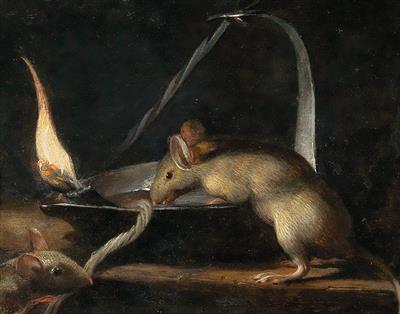Attributed to Trophime Bigot

(Arles 1579–1650 Avignon)
Two mice nibbling on a candlewick,
oil on copper, 12 x 15,5 cm, framed
The present painting, which as a nocturnal animal piece is an unusual pictorial invention, is traditionally attributed to Bigot.
From around 1620 to 1634, Bigot was active in Rome. Between 1638 and 1642 he lived in Aix-en-Provence, where he painted a number of altarpieces. Before and after his years in Aix, he spent time in Arles. In 1644 he finally settled in Avignon. In 1960, Benedict Nicolson managed to compile a group of some forty paintings as the work of an anonymous artist who was given the name “Candlelight Master”. In an article published in 1964, he finally succeeded in identifying this master as Bigot. Earlier it had been assumed that these works could also have been painted by Gerrit van Honthorst, Matthias Stom, or Georges de La Tour. Nicolson’s attribution to Bigot, however, met with wide acceptance.
Because of stylistic differences between the works from his Roman and French periods, it had been proposed that there might have been two painters named Bigot. The hypothesis that they could have been father and son was successfully refuted through documents in the municipal archives of Arles. A copper engraving based on a lost painting by Bigot of the Madonna and Child in the Workshop of Joseph (private collection) made in Aix-en-Provence possibly provides a connection between his Roman and Provençal output. In the early seventeenth century, Joachim von Sandrart already knew of a Caravaggesque painter of nocturnal busts called Trufemondi; according to Jean Boyer, the name refers to Bigot.
Esperto: Dr. Alexander Strasoldo
 Dr. Alexander Strasoldo
Dr. Alexander Strasoldo
+43 1 515 60 403
old.masters@dorotheum.com
17.10.2017 - 18:00
- Prezzo realizzato: **
-
EUR 35.503,-
- Stima:
-
EUR 20.000,- a EUR 30.000,-
Attributed to Trophime Bigot
(Arles 1579–1650 Avignon)
Two mice nibbling on a candlewick,
oil on copper, 12 x 15,5 cm, framed
The present painting, which as a nocturnal animal piece is an unusual pictorial invention, is traditionally attributed to Bigot.
From around 1620 to 1634, Bigot was active in Rome. Between 1638 and 1642 he lived in Aix-en-Provence, where he painted a number of altarpieces. Before and after his years in Aix, he spent time in Arles. In 1644 he finally settled in Avignon. In 1960, Benedict Nicolson managed to compile a group of some forty paintings as the work of an anonymous artist who was given the name “Candlelight Master”. In an article published in 1964, he finally succeeded in identifying this master as Bigot. Earlier it had been assumed that these works could also have been painted by Gerrit van Honthorst, Matthias Stom, or Georges de La Tour. Nicolson’s attribution to Bigot, however, met with wide acceptance.
Because of stylistic differences between the works from his Roman and French periods, it had been proposed that there might have been two painters named Bigot. The hypothesis that they could have been father and son was successfully refuted through documents in the municipal archives of Arles. A copper engraving based on a lost painting by Bigot of the Madonna and Child in the Workshop of Joseph (private collection) made in Aix-en-Provence possibly provides a connection between his Roman and Provençal output. In the early seventeenth century, Joachim von Sandrart already knew of a Caravaggesque painter of nocturnal busts called Trufemondi; according to Jean Boyer, the name refers to Bigot.
Esperto: Dr. Alexander Strasoldo
 Dr. Alexander Strasoldo
Dr. Alexander Strasoldo
+43 1 515 60 403
old.masters@dorotheum.com
|
Hotline dell'acquirente
lun-ven: 10.00 - 17.00
old.masters@dorotheum.at +43 1 515 60 403 |
| Asta: | Dipinti antichi |
| Tipo d'asta: | Asta in sala |
| Data: | 17.10.2017 - 18:00 |
| Luogo dell'asta: | Wien | Palais Dorotheum |
| Esposizione: | 07.10. - 17.10.2017 |
** Prezzo d’acquisto comprensivo dei diritti d’asta acquirente e IVA(Paese di consegna Austria)
Non è più possibile effettuare un ordine di acquisto su Internet. L'asta è in preparazione o è già stata eseguita.
